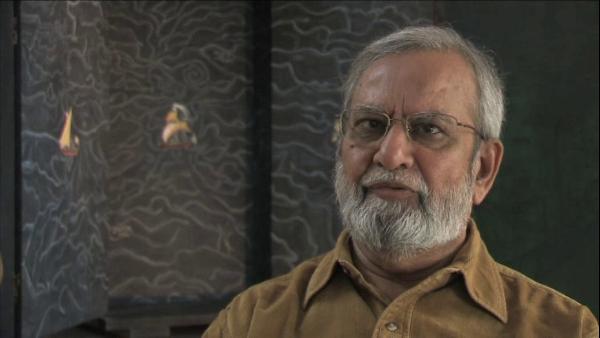NEXT STORY

Teaching and painting
RELATED STORIES

NEXT STORY

Teaching and painting
RELATED STORIES


|
Views | Duration | |
|---|---|---|---|
| 41. About my paintings (Part 1) | 51 | 08:33 | |
| 42. About my paintings (Part 2) | 37 | 07:23 | |
| 43. Creating panels for The Times of India office | 24 | 03:15 | |
| 44. Speaking in many tongues | 52 | 06:35 | |
| 45. Maps and palimpsests in my work | 63 | 06:55 | |
| 46. Inter-faith marriages and difficulties being a Muslim | 70 | 05:16 | |
| 47. City for Sale | 72 | 03:16 | |
| 48. Teaching and painting | 27 | 05:22 | |
| 49. Salman Rushdie and magic realism | 51 | 03:30 | |
| 50. Exhibition in Paris and stories in my work | 36 | 06:19 |


City for Sale was ’81 to ’84.
And eventually that was bought by the Victoria and Albert Museum?
Yes.
In London. But that, in a way, was something, it was probably the most politicised painting you’ve made to that point?
Yes, that’s true, but that was a time when there were a spate of riots, you know. And that over the years, you know, I’ve seen... beginning with... I mean, the first and the largest, the most horrific riots were in ’69. But after that it has been a kind of relentless sort of spate of riots. And you would have several in the year, I read somewhere in, one year there was something like 100 times these conflagrations took place in a city like Baroda and Ahmedabad. It was that period in which such things were happening and that painting, you know, emerged out of that experience. In fact, I almost felt very superstitious about that painting because it continued for 3 years, 3 or 4 years, and every time I would start there would be yet another riot. But it was a statement that I thought had to be made and in a way it was part of that kind of a confessional that I’ve spoken of earlier and it’s about the city that I live in and it has something to do with the cities that I admire and also the city paintings that I have admired. So it has that backdrop. In the middle is a figure, if you look at it carefully, there is a man who paints a cinema signboard, you know. He is painting the face of a cinema actress and actually he is painting the pupil of the figure. So this is a kind of a reference to, what do we call patas, that is a scroll painting in Bengal where there is a tradition that the traditional scroll painters carry with them an image without, I mean, the face without the pupil. And they go to the house where that has taken place and they ritually paint the eyeball, which is meant to be a release of sorts, you know, of the spirit. Well, here it’s sort of painted on the face of a very beautiful, well known actress, Rekha. So in a way it cuts both ways because there is an irony about the film being shown and the riots raging right at the top. So there is no eyeball in the painting.
Gulammohammed Sheikh is an Indian painter, writer and art critic who has been a major figure in the Indian art world for half a century. His artistic career is closely associated with the renowned MS University of Baroda in Gujarat where after gaining his Master's degree, Sheikh went on to teach in the Faculty of Fine Arts, and where he was appointed Professor of Painting in 1982.
Title: City for Sale
Listeners: Timothy Hyman
Timothy Hyman is a graduate of Slade School of Fine Art, London, in which he has also taught. In 1980 and 1982, he was Visiting Professor in Baroda, India. Timothy Hyman has curated many significant art exhibitions and has published articles and monographs on both European and Indian artists.
Duration: 3 minutes, 16 seconds
Date story recorded: December 2008
Date story went live: 18 November 2010